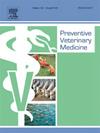Epidemiology, risk factor and R0 investigation of an outbreak of lumpy skin disease in cattle in Punjab, India
IF 2.4
2区 农林科学
Q1 VETERINARY SCIENCES
引用次数: 0
Abstract
Lumpy skin disease (LSD) is an emerging disease in India, causing substantial economic losses to the livestock industry. This study aimed to estimate epidemiologic parameters, including R0, and risk factors associated with an LSD outbreak in cattle (November 2021—August 2022) in Punjab, India. Animals were unvaccinated, and the village’s animals were isolated due to district animal movement restrictions. Univariable regression analyses investigated the association of farm and animal level explanatory variables with disease outcome. The exponential growth (EG) method using the gamma-distributed serial intervals between cases was used to estimate the basic reproduction number (R0). Buffalo (N = 603) in the village were not affected. The attack rate in cattle was 5.3 % (95 % CI 3.8–7.5), mortality rate 1.1 % (95 % CI 0.5–2.3), and case fatality rate 20 % (95 % CI 9.5–37.3). The odds of indigenous cattle being a case was higher than crossbred cattle (OR 3.9, 95 % CI 1.1–12.5, P = 0.01). Estimated animal-level R₀ was 1.82 (range 0.55–3.57; 95 % CI 0.01–7.83). Univariable logistic regression analysis identified significant risk factors at the farm-level including the number of cattle (OR 1.19, 95 % CI 1.03–1.43, P = 0.01), presence of blood sucking flies (OR 8.21, 95 % CI 2.11–31.92, P < 0.01) and ticks (OR 3.12, 95 % CI 1.03–9.52, P = 0.038). Therefore, prioritizing vaccination to cattle over buffalo during limited vaccination supplies and control measures for both direct and indirect transmission must be adopted in dairy farms, and monitoring R₀ could be used to determine the effectiveness of control measures either in the field or in LSD simulation models.
印度旁遮普省牛群肿块性皮肤病暴发的流行病学、危险因素和R0调查
疙瘩性皮肤病(LSD)是印度的一种新兴疾病,给畜牧业造成了巨大的经济损失。本研究旨在估计与印度旁遮普省(2021年11月至2022年8月)牛中LSD暴发相关的流行病学参数,包括R0和危险因素。动物没有接种疫苗,由于地区动物活动限制,该村的动物被隔离。单变量回归分析调查了农场和动物水平解释变量与疾病结局的关系。利用病例间γ分布序列区间的指数增长方法估计基本繁殖数(R0)。该村水牛(N = 603)未受影响。牛的发病率为5.3 %(95 % CI 3.8-7.5),死亡率为1.1 %(95 % CI 0.5-2.3),病死率为20 %(95 % CI 9.5-37.3)。土牛发病几率高于杂交牛(OR 3.9, 95 % CI 1.1-12.5, P = 0.01)。估计动物水平R 0为1.82(范围0.55-3.57;95 % ci 0.01-7.83)。单变量逻辑回归分析确定的重大风险因素在农场层次包括牛的数量(95 %可信区间1.03 - -1.43或1.19,P = 0.01),吸血的苍蝇(95 %可信区间2.11 - -31.92或8.21,P & lt; 0.01)和蜱虫(95 %可信区间1.03 - -9.52或3.12,P = 0.038)。因此,在有限的疫苗接种供应期间,必须优先为牛而不是水牛接种疫苗,并在奶牛场采取直接和间接传播的控制措施,监测R 0可用于确定现场或LSD模拟模型中控制措施的有效性。
本文章由计算机程序翻译,如有差异,请以英文原文为准。
求助全文
约1分钟内获得全文
求助全文
来源期刊

Preventive veterinary medicine
农林科学-兽医学
CiteScore
5.60
自引率
7.70%
发文量
184
审稿时长
3 months
期刊介绍:
Preventive Veterinary Medicine is one of the leading international resources for scientific reports on animal health programs and preventive veterinary medicine. The journal follows the guidelines for standardizing and strengthening the reporting of biomedical research which are available from the CONSORT, MOOSE, PRISMA, REFLECT, STARD, and STROBE statements. The journal focuses on:
Epidemiology of health events relevant to domestic and wild animals;
Economic impacts of epidemic and endemic animal and zoonotic diseases;
Latest methods and approaches in veterinary epidemiology;
Disease and infection control or eradication measures;
The "One Health" concept and the relationships between veterinary medicine, human health, animal-production systems, and the environment;
Development of new techniques in surveillance systems and diagnosis;
Evaluation and control of diseases in animal populations.
 求助内容:
求助内容: 应助结果提醒方式:
应助结果提醒方式:


